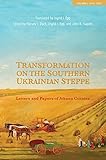Transformation on the Southern Ukrainian Steppe : Letters and Papers of Johann Cornies, Volume I: 1812-1835 / ed. by Harvey L. Dyck, Ingrid I. Epp, John R. Staples.
Material type: TextSeries: Tsarist and Soviet Mennonite Studies ; 1Publisher: Toronto : University of Toronto Press, [2015]Copyright date: ©2015Description: 1 online resource (632 p.) : 3 mapsContent type:
TextSeries: Tsarist and Soviet Mennonite Studies ; 1Publisher: Toronto : University of Toronto Press, [2015]Copyright date: ©2015Description: 1 online resource (632 p.) : 3 mapsContent type: - 9781442622371
- 940.2 22
- D250 C67 2015eb
- online - DeGruyter
| Item type | Current library | Call number | URL | Status | Notes | Barcode | |
|---|---|---|---|---|---|---|---|
 eBook
eBook
|
Biblioteca "Angelicum" Pont. Univ. S.Tommaso d'Aquino Nuvola online | online - DeGruyter (Browse shelf(Opens below)) | Online access | Not for loan (Accesso limitato) | Accesso per gli utenti autorizzati / Access for authorized users | (dgr)9781442622371 |
Frontmatter -- Contents -- List of Maps -- Preface -- Acknowledgments -- Translator’s Note -- Introduction -- Part One: Correspondence, 1812–1836 -- 1812–1823 -- 1824 -- 1825 -- 1826 -- 1827 -- 1828 -- 1829 -- 1830 -- 1831 -- 1832 -- 1833 -- 1834 -- 1835 -- 1836 -- Part Two: Reports and Studies by Johann Cornies -- Editors’ Introduction -- I. The Nogai Tatars in Russia -- II. The Doukhobors of the Molochnaia Area -- III. Survey of the History and Conditions of the German Colonists Settled on the Right Bank of the Molochnaia River -- IV. The Molokan Sect in the Molochnaia -- Appendix I: Genealogy of Johann Cornies’ Immediate Family -- Appendix II: List of Correspondents -- Appendix III: Glossary -- Appendix IV: Chronology -- Index
restricted access online access with authorization star
http://purl.org/coar/access_right/c_16ec
In the eighteenth and nineteenth centuries, the Russian empire opened the grasslands of southern Ukraine to agricultural settlement. Among the immigrants who arrived were communities of Prussian Mennonites, recruited as “model colonists” to bring progressive agricultural methods to the east. Transformation on the Southern Ukrainian Steppe documents the Tsarist Mennonite experience through the papers of Johann Cornies (1789–1848), an ambitious and energetic leader of the Mennonite colony of Molochna.Cornies was well connected in the imperial government, and his papers offer a window not just into the world of the Molochna Mennonites but also into the Tsarist state’s relationship with the national minorities of the frontier: Mennonites, Doukhbors, Nogai Tartars, and Jews. This selection of his letters and reports, translated into English, is an invaluable resource for scholars of all aspects of life in Tsarist Ukraine and for those interested in Mennonite history.
Mode of access: Internet via World Wide Web.
In English.
Description based on online resource; title from PDF title page (publisher's Web site, viewed 02. Jun 2024)


